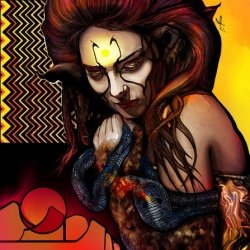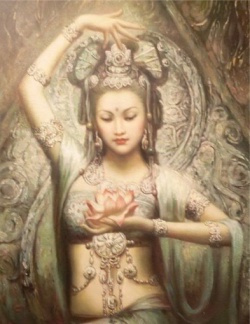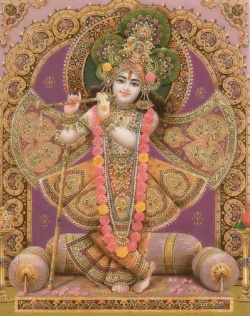Deity
Click here to see other articles relating to word Deity
A deity (Listeni/ˈdiː.ɨti/ or Listeni/ˈdeɪ.ɨti/) is a being, natural, supernatural or preternatural, with superhuman powers or qualities, and who may be Thought of as holy, divine, or sacred. Believers may
consider or believe that they can communicate with the deity, who can respond supernaturally to their entreaties, and that the deity's myths are true. Some religions have one supreme deity, others have multiple deities of various ranks.
C. Scott Littleton's Gods, Goddesses, and Mythology defined a deity as "a being with powers greater than those of ordinary humans, but who interacts with humans, positively or negatively, in ways that carry humans to new levels of Consciousness beyond the grounded preoccupations of ordinary Life."
Deities are depicted in a variety of forms, but are also frequently expressed as having human Form. Some faiths and traditions consider it blasphemous to imagine or depict the deity as having any concrete Form.
Deities are often Thought to be immortal, and are commonly assumed to have personalities and to possess Consciousness, intellects, Desires, and emotions comparable but usually superior to those of humans. A male deity is a God, while a female deity is a goddess.
Natural Phenomena whose causes are not understood, such as lightning and catastrophes such as earthquakes and floods, are sometimes attributed to them. They may be Thought to be able to work supernatural miracles and
to be the authorities and controllers of various aspects of human Life (such as birth or an afterlife). Some deities are asserted to be the directors of time and Fate itself, to be the givers of human law and
Morality, to be the ultimate judges of human worth and behavior, and to be the designers and creators of everything (the Earth or Universe and all contents).
Etymology
The word "deity" derives from the Latin deus ("God"), which is related through a common Indo-European origin to Sanskrit Deva ("God"), Devi ("goddess"), divya ("transcendental", "
Spiritual"). The root is related to words for "sky", such as Latin dies ("day"), and the Sanskrit div, diu ("sky", "day", "shine").
Other words for the concept
The English word "God" comes from Anglo-Saxon; similar words are found in many Germanic languages (e.g. the German "Gott" — "God").
ʾIlāh (Arabic: إله; plural: آلهة ʾālihah) is an Arabic term meaning "deity". The feminine is ʾilāhah (إلاهة, meaning "goddess"); with the article, it appears as al-ʾilāhah الإلاهة. It appears in the name of the
monotheistic God of Islam as al-lāh, that is, translated, "the God". All of them come from the most basic original Form known to pre-Semite peoples and others in the Levante as Elah, and from the God El. In some
cases, it is used by Arabic-speaking Christians and Jews, although not as frequently as other titles, such as Rabb, or "Lord" — a title also used by Muslims for Allah — similar to the Hebrew use of Adonai, which
is the most frequently used by Jews of all languages, along with HaShem or "the Name". Amongst Christians, Yasu—an Arabic transliteration of the name of the Christian Jesus—Yahweh, or Shaddai, that is, translated, "Almighty", are common, with some other names and titles generally borrowed a
transliterations from Hebrew, Aramaic, and Greek. In Malaysia, many States have laws prohibiting non-Muslims from using the word "Allah", but these have been ruled unconstitutional insofar as they do not involve the Propagation of non-Muslim religions to Muslims.
ʾIlāh is cognate to Northwest Semitic ʾēl and Akkadian ilum. The word is from a Proto-Semitic archaic biliteral ʔ-l meaning "God" (possibly with a wider meaning of "strong"), which was extended to a regular triliteral by the addition of a h (as in Hebrew ʾelōAh, ʾelōhim).
The word is spelled either إله with an optional diacritic alif to mark the ā only in Quranic texts or (more rarely) with a full alif, إلاه. The term is used throughout the Quran in passages detailing the existence of God and of the beliefs of non-Muslims in other divinities. Notably, the first statement of the šAhādah (the Muslim confession of Faith) is, "there is no ʾilāh but al-lāh", that is, translated, "there is no deity except for Allah" or "there is no God except for the [one] God".
The Persian word Khuda (Persian: خدا ) can be translated as God, Lord or king, and is also used today to refer to God in Islam by Persian and Urdu speakers. (But "Allah" is more common.)
Turkic word for God is Tengri, it exists as Tanrı in Turkish. It is in some cases used interchangibly with "Allah".
Relation with humanity
Theories and myths about, and modes of worship of, deities are largely a matter of Religion. At present, the majority of humans are adherents of some Religion, and this has been true throughout recorded human history.
Human burials from between 50,000 and 30,000 B.C. provide evidence of human belief in an afterlife and possibly in deities, although it is not clear when human belief in deities became the dominant view.
Some deities are Thought to be invisible or inaccessible to humans, dwelling mainly in otherworldly, remote or secluded and holy places, such as the concepts of Heaven, and Hell, the sky, the under-World, under the sea, in the high mountains or deep forests, or in a supernatural plane or celestial sphere. Typically, they rarely reveal or manifest themselves to humans, and make themselves known mainly through their effects. Monotheistic deities are often Thought of as being omnipresent, though invisible.
Often people feel an obligation or submission to their deity, although some view their deity as something that serves them.
Ivory figure of Wen Chang, a Chinese God of culture and literature (Ming Dynasty, ca. 1550-1644)
Folk religions usually contain active and worldly deities.
In polytheism, deities are conceived of as a counterpart to humans: humans are defined by their station subject to the deities, nourishing them with prayers or sacrifices, and deities are defined by their sovereignty over humans, punishing and rewarding them, but also dependent on their worship. This same concept is also present in monotheistic and henotheistic religions.
The boundary between human and divine in most cultures is by no means absolute. Demigods are the offspring from a union of a human with a deity, and most royal houses in Antiquity claimed divine ancestors.
beginning with Djedefra (26th century BC), the Egyptian pharaohs called themselves "Son of Ra" as well as "Bull (son) of his Mother" among their many titles. One, Hatshepsut, who ruled from 1479 BC to 1458 BC, traced her heritage not only to her father, Thutmose I, who would have become deified upon his Death—but also to the deity, Mut, as a direct ancestor.
Some human rulers, such as the Kings of Egypt, the Japanese Tennos, and some Roman Emperors have been worshipped by their subjects as deities while still alive. The earliest ruler known to have claimed divinity is Naram-Sin of Akkad (22nd century BC). In many cultures, rulers and other prominent or holy persons may be Thought to become deities upon Death (see Osiris, ancestor worship, canonization).
Forms of theism
Some religions are monotheistic and assert the existence of a unique deity. In the English Language, the common noun God is equivalent to deity, while the proper noun God (capitalized) references the unique deity of monotheism. Pantheism considers The Universe itself to be a deity.
Dualism is the view that there are two deities: a deity of good who is opposed and thwarted by a deity of Evil, of equal Power. Manichaeism, Zoroastrianism, and Gnostic sects of [[Wikipedia:Christianity|Christianity]] are, or were, dualist. Polytheism asserts the existence of several deities, who together Form a pantheon.
Monolatry is a type of polytheism in which the existence of multiple deities is recognized, but worship is given only to one. Henotheism is a Form of polytheism in which only one deity is
worshipped. Animism is the belief that Spirits inhabit every existing thing, including plants, minerals, Animals, and,
including all the elements, air, water, Earth, and Fire. The anthropologist E. B. Tylor argued that Religion originally took an animist Form. Theism is the view that at least one deity exists.
Adherents of polytheistic religions, such as certain schools of Hinduism, may regard all deities in the pantheon as manifestations, aspects, or multiple personalities of the single supreme
deity, and the religions may be more akin to pantheism, monotheism, or henotheism than is initially apparent to an observer.
The many religions do not generally agree on which deities exist, although sometimes the pantheons may overlap, or be similar except for the names of the deities. It is frequently argued that Judaism, [[Wikipedia:
Christianity]], and Islam all worship the same monotheistic deity, although they differ in many important details.
Comparative Religion studies the similarities and contrasts in the views and practices of various religions. Philosophy of Religion discusses philosophical issues related to theories about deities.
Anthropology of Religion studies religious institutions in relation to other social institutions, the comparison of religious beliefs and practices across cultures, and describes each Religion as a cultural product, created by the human community that worships it.
Narratives about deities and their deeds are referred to as myths, the study of which is mythology. The word "myth" has an overtone of fiction, so religious people commonly (although not invariably) refrain from using this term in relation to the stories about deities which they themselves believe in.
Islam
Muslims believe that God is one and incomparable and the purpose of existence is to know, serve, and Love God. It is the Muslim belief that Islam is the complete and universal version of a [
[[[primordial]]]] Faith that was revealed at many times and places before, including through Abraham, Moses and Jesus, who are considered prophets. Muslims maintain that previous messages and revelations have b
een partially changed or corrupted over time, but consider the Quran to be both the unaltered and the final revelation of God. The equivalent word for deity in Arabic, is ilāh (إله).
Hinduism
The worship of Shiva is a pan-Hindu tradition, practiced widely across all of India, Sri Lanka and Nepal. Shaivism has many different schools showing both regional variations and differences in philosophy.
Shaivism has a vast literature that includes texts representing multiple philosophical schools, including non-dualist (abheda), dualist (bheda), and non-dual-with-dualism (bhedābheda) perspectives. Some
people believe that artifacts from Mohenjo-daro, Harappa and other archaeological sites of northwestern India and Pakistan indicate that some early Form of Shiva worship was
practiced in the Indus Valley. These artifacts include lingams and the "Pashupati seal" that has been the subject of much study. The Indus Valley civilization reached its peak around 2500-2000 BC, when trade links with Mesopotamia are known to have existed, was in decline by 1800 BC, and faded away by 1500 BC.
Buddhism
Buddhist temple image of Vaisravana, one of the Four Heavenly Kings (Ssangbongsa, South Korea)
In Buddhism\Buddhist mythology, Devas are beings inhabiting certain happily placed worlds of Buddhist cosmology. These beings are mortal (being part of Saṃsāra), numerous, and are respected but not worshipped; it is also common for Yidams to be called deities, although the nature of Yidams are distinct from what is normally meant by the term.
The Buddhist Madhyamaka argue strongly against the existence of a reificating creator or essential being (such as Brahman). Some Prasangikas hold that even the conventional existence of an essential being is a non-existent, whereas others consider that the conventional existence of such a being is an existent.
Some modern Buddhists, especially in the west, believe that deities exist in the same manner that elves or unicorns do - as an archetypal consensual entity that serves a symbolic purpose in the popular imagination.
Though this may seem a rather weak basis of existence for some, as many Buddhists (such as the Yogacara) deny any objective existence (of e.g. a chair), and many more deny any sort of essential existence of Phenomena at all, the distinction between the existence and non-existence of consensual entities is important to Buddhist Philosophy.
Polytheism
A pantheon (from Greek Πάνθειον, from πᾶν, all + θεός, God) is a set of all the deities of a particular polytheistic Religion or mythology, such as the Egyptian pantheon, or the Greek pantheon. A pantheon may include deities of vastly differing importance and scope.
Max Weber's 1922 opus, Economy and Society discusses the link between a pantheon of deities and the development of monotheism.
Monotheism
In some cases, especially the monotheistic Abrahamic God or the supreme deity of henotheistic religions, the divine is not Thought of by many believers in the same terms as deities - as a powerful, anthropomorphic supernatural being - but rather becomes Esoteric, and ineffable - the Ultimate, the Absolute Infinite, the Transcendent, the One, the All, Existence, becoming or Being itself, the ground of being, the nondualistic, etc.
In this view, God (Allah, Brahman, Elohim, Jesus Christ, Waheguru, etc.) is not a deity, and the anthropomorphic myths and iconography associated with him are regarded as symbolism, allowing worshippers to speak and think about something which otherwise would be beyond human comprehension.
Scientific positions on deities
Pascal Boyer argues that while there is a wide array of supernatural concepts found around the World, in general, supernatural beings tend to behave much like people. The construction of Gods and Spirits like persons (anthropomorphism) is one of the oldest characteristics of Religion. He cites examples from Greek Mythology which is, in his opinion, more like a modern soap opera than other religious systems. Anthropologist Stewart Elliott Guthrie, contends that people project human features onto non-human aspects of the World because it makes those aspects more familiar. Sigmund Freud also suggested that God concepts are projections of one's father. Likewise, Émile Durkheim was one of the earliest to suggest that Gods represent an extension of human social Life to include supernatural beings. In line with this reasoning, psychologist Matt Rossano contends that when humans began living in larger groups, they may have created Gods as a means of enforcing Morality. In small groups, Morality can be enforced by social forces such as gossip or reputation. However it is much harder to enforce Morality using social forces in much larger groups. He indicates that by including ever watchful Gods and Spirits, humans discovered an effective strategy for restraining selfishness and building more cooperative groups.
More recently, neurotheology, a term which was originally introduced by Aldous Huxley, studies religious experience of God and Spirituality in terms of cognitive neuroscience. Closely related, evolutionary psychology hypothesizes on the reason for the existence of these cognitive processes by examining the survival and reproductive functions they might serve.Memes for instance, might help to explain how cultural ideas such as the conception of deities circulated and have garnered special social acceptance by the community. It is hypothesized that deities are generally accepted by people because it is an extension to the human need to socialize with individuals of the same community.
Source
Deity (Wyl. lha) — Sogyal Rinpoche writes:
- In Tantra the principle of deities is a way of communicating. It is difficult to relate to the presence of enlightened energies if they have no form or ground for personal communication. The deities are understood as metaphors, which personalize and capture the infinite energies and qualities of the wisdom mind of the buddhas. Personifying them in the form of deities enables the practitioner to recognize them and relate to them. Through training in creating and reabsorbing the deities in the practice of visualization, he or she realizes that the mind that perceives the deity and the deity itself are not separate.[1]
Footnotes
- ↑ Sogyal Rinpoche, The Tibetan Book of Living and Dying, page 289.




